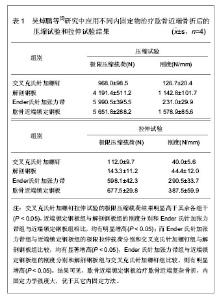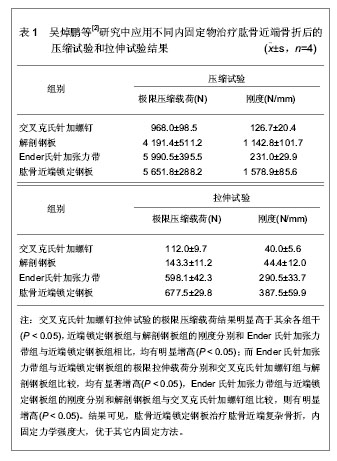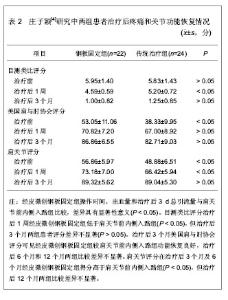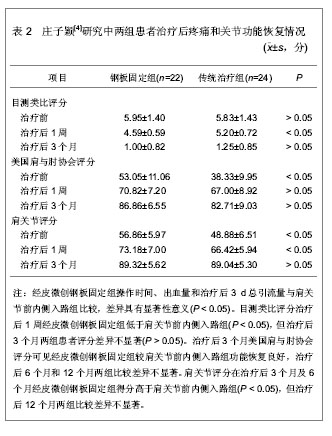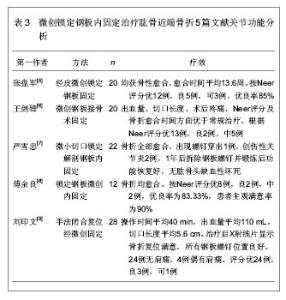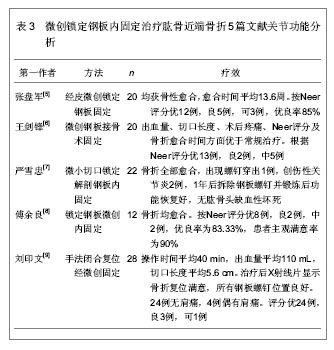| [1] 中国知网.中国学术期刊总库[DB/OL]. 2013-5-12. https://www.cnki.net[2] 吴焯鹏,白波,余楠生,等.肱骨近端复杂骨折内固定的生物力学研究[J].中国临床解剖学杂志,2009,27(4):477-479.[3] 陈强,陆义安,陈云丰,等.足部X形AO锁定钢板治疗肱骨大结节骨折[J].国际骨科学杂志,2012,33(1):31-33.[4] 庄子颖.经皮微创接骨术与传统手术治疗肱骨近端骨折的临床疗效比较[D].福建:福建中医药大学,2012:4-5.[5] 张盘军,蒋建农,王勇,等.经皮微创锁定钢板固定治疗肱骨近端骨折[J].中国骨与关节损伤杂志,2012,27(9):840-841.[6] 王剑锋,宋海波,顾豪杰,等.微创钢板接骨术治疗老年肱骨近端骨折的病例对照研究[J].中国骨伤,2012,28(6):487-489.[7] 严雪忠,留成胜,黎高明.微小切口锁定解剖钢板内固定治疗肱骨近端骨折22例分析[J].现代实用医学,2012,24(6):643-645.[8] 傅余良,赵隆队,朱琪.锁定钢板微创治疗老年人肱骨近端骨折的疗效[J].实用临床医学(江西),2012,12(12):40-41,43.[9] 刘印文.手法闭合复位经皮微创固定治疗肱骨近端骨折[J].中国骨伤,2012,24(11):949-951.[10] Björkenheim JM, Pajarinen J, Savolainen V. Internal fixation of proximal humeral fractures with a locking compression plate: a retrospective evaluation of 72 patients followed for a minimum of 1 year.Acta Orthop Scand. 2004;75(6):741-745.[11] Bigorre N, Talha A, Cronier P, et al.A prospective study of a new locking plate for proximal humeral fracture.Injury.2009;40(2):192-196.[12] Greiwe RM, Archdeacon MT. Locking plate technology: current concepts.J Knee Surg. 2007;20(1):50-55.[13] Björkenheim JM, Pajarinen J, Savolainen V.Internal fixation of proximal humeral fractures with a locking compression plate: a retrospective evaluation of 72 patients followed for a minimum of 1 year.Acta Orthop Scand.2004;75(6):741-745.[14] Fankhauser F, Boldin C, Schippinger G, et al.A new locking plate for unstable fractures of the proximal humerus.Clin Orthop Relat Res.2005;(430):176-181.[15] McLaurin TM. Proximal humerus fractures in the elderly are we operating on too many? Bull Hosp Jt Dis.2004;62(1-2): 24-32.[16] 席银辉.锁定钢板治疗肱骨近端骨折的疗效分析[J].实用骨科杂志,2008,14(3):182-183.[17] 张岩,杨铁毅,刘树义,等.应用锁定接骨板微创固定治疗肱骨近端骨折31例初步随访分析[J].中国矫形外科杂志,2009,17(12): 898-900.[18] Gardner MJ, Griffith MH, Dines JS, et al. The extended anterolateral acromial approach allows minimally invasive access to the proximal humerus. Clin Orthop Relat Res. 2005; (434):123-129.[19] 王俊生,武志兵.腋神经、桡神经与肱骨关系的应用解剖[J].创伤外科杂志2003,5(1):64.[20] 刘德荣,梁加利,陆耀刚.微创技术植入锁定加压钢板治疗肱骨干近端骨折[J].中国修复重建外科杂志,2009,23(11):1282-1284. |
